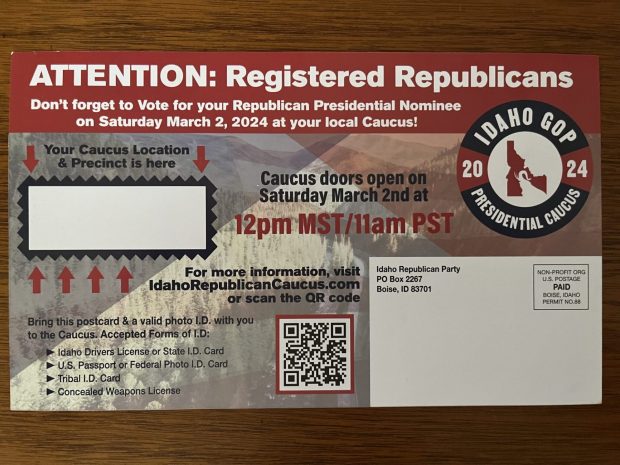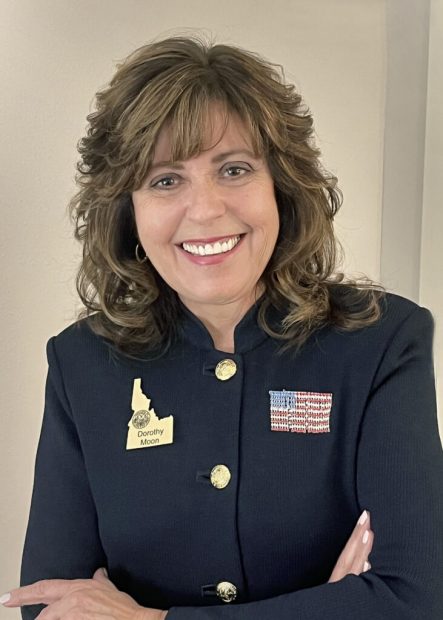Registered Republican voters will gather at 210 different caucus locations on March 2 to help select the GOP nominee for president.
The caucus is new this year, a result of the Idaho Legislature seemingly unintentionally eliminating the presidential primary election last year.
Idaho’s March 2 Republican presidential caucus will take place just before the March 5 “Super Tuesday” primaries, the date when there are more primary elections and caucuses than any other day this year.
The Idaho caucus will begin at 12 p.m. Mountain time and 11 a.m. Pacific time.
Idaho Republican Party Chairwoman Dorothy Moon said the caucus will feature one round of voting and is expected to last for 90 minutes to two hours at the larger sites, depending on how long registration and credentialing takes. After tabulating results from all 210 caucus sites, party leaders hope to announce the caucus results by 5 or 6 p.m. March 2, Moon said.
Up for grabs in Idaho are 32 delegates, which Republican presidential candidates hope to amass as part of their bid to secure their party’s nomination. The Des Moines Register reported it will take 1,215 delegates to win the party’s nomination.
There are six Republican candidates on the ballot in Idaho, although three have dropped out of the race.
Idaho ballots will include:
Former President Donald TrumpFormer U.N. Ambassador Nikki HaleyBusinessman and pastor Ryan L. BinkleyFlorida Gov. Ron DeSantisFormer New Jersey Gov. Chris ChristieAuthor and businessman Vivek Ramaswamy
DeSantis, Christie and Ramaswamy have all dropped out of the race at this point, but their names are still on the ballot in Idaho, Moon said.
What is different with a presidential caucus in Idaho?
Unlike a state primary election, the caucus is planned, paid for and run by the Idaho Republican Party.
“I think the caucus is really getting back to the grassroots and it’s not being paid for by the taxpayers, and I think that is huge,” Moon said in an interview last week.
Moon said the Idaho Republican Party should be able to conduct the caucus for less than $300,000, compared to $2.7 million for a state-run primary election.
In order to participate in the Republican caucus, voters have to have met the Idaho Republican Party’s Dec. 31 party affiliation deadline. Republicans also need to participate in-person at their specific caucus site that is assigned based on their precinct in their county. There is no exception for members of the armed services serving away from home, missionaries, people who are physically unable to to travel or attend, people who are ill, people who are working or people who cannot obtain child care. Moon encourages Republicans to bring their children with them to the caucus.
There are several things that will be different with the caucus compared to the primary. The most obvious is that a voter’s caucus location will be different from the normal polling place voters are used to. There will be 210 caucus locations around the state, ranging from churches to schools to county offices to Deer Flat National Wildlife Refuge visitor center in Nampa.
Idaho Republican Party officials are mailing postcards with a red border to every registered Republican household in the state this week, Moon said. That postcard will list the voter’s caucus location and precinct location on it, and Moon encouraged Republicans to hang on to their postcard and bring it with them to the caucus, along with their ID. If they forget or lose their postcard, Republicans can also find their caucus location using their county, voting precinct and legislative districts, which is available through the Vote Idaho website.

What will Idaho’s Republican caucus be like?
Each of the 210 caucus sites might be a little bit different. Moon said the caucuses are likely to include videos from the presidential candidates or a message from a candidate’s surrogate. Republican presidential candidates themselves would also be welcome to attend caucus sites in Idaho and deliver a message to voters, Moon said.
The pledge of allegiance, a prayer and a song may also be included, Moon said.
Once a voter enters a caucus site, party officials will use a poll book and photo identification to verify each voter’s identification to ensure they are eligible to participate, Moon said.
Accepted forms of identification include:
An Idaho driver’s license or state ID card.A U.S. passport or federal photo ID.A tribal ID card.A concealed weapons license.
After a voter’s identification is verified, they will receive a special stamp and a ballot, Moon said. Idaho Republicans will use paper ballots at all caucus sites, Moon said. There will be one round of voting, and voters will be free to leave the caucus once they submit their ballot, Moon said.
Idaho Republican Party officials at the caucus site will count the ballots by hand, Moon said. Officials will not use scanners or machines to tabulate the results.

Ballots will be counted by hand with multiple Republican witnesses present, Moon said. Candidates could also designate a witness to watch the count, Moon said.
After they finish counting ballots, officials will recount the ballots. Once they reach the same number twice, that is it, Moon said. Officials from each caucus site will then phone results into Idaho Republican Party headquarters, where they will tabulate totals.
“Hopefully we can announce as soon as we know a majority,” Idaho Republican Party Executive Director KiiraTurnbow said in an interview last week. “Hopefully by 5 or 6 p.m. we will have a result, possibly earlier.”
“We’ll open up the doors (to our party headquarters) and Dorothy (Moon) will do a live stream or video, or if press chooses to be out in the hall they can be videoing her announcing the results along with the statement that we are going to put out,” Turnbow added.
Idaho Republican Party officials plan to initially announce the raw statewide vote totals and the winner. Later on, they hope to post voting results broken down by each of the 210 caucus sites and provide information such as voter turnout.
How will Idaho’s Republican delegates be assigned?
Idaho’s Republican presidential caucus will not be a winner-take-all unless one candidate wins a simple majority of the votes. If any candidate does win at least 50% plus one of the caucus votes, that candidate will win all 32 delegates, Moon said. If not, the delegates will be split proportionally among all candidates who receive at least 15% of the vote.
Caucuses generally produce lower voter turnout than a primary election because of the in-person requirements and the longer time commitment involved.
“You look at the guide of a 10% turnout as we had in the 2012 caucus, and kind of nationwide that’s what you get is about 10%,” Moon said.
Moon said Republicans will have enough ballots on hand to cover more than 50% of the registered Republicans in each of the precincts assigned to a caucus location.
Personally, Moon said she would love to see 100,000 of Idaho’s 585,000 registered Republicans caucus.
“I would love to see 100,000 people turn out so that we can beat Iowa’s caucus result,” Moon said. “I think the idea of people getting excited is what excites me.”
Idaho Capital Sun is part of States Newsroom, a nonprofit news network supported by grants and a coalition of donors as a 501c(3) public charity. Idaho Capital Sun maintains editorial independence. Contact Editor Christina Lords for questions: [email protected]. Follow Idaho Capital Sun on Facebook and Twitter.
